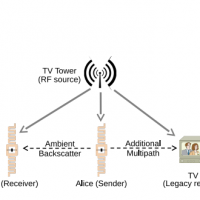Ambient Backscatter as Battery Replacement Gaining Public Visibility

Wearable computing and the Internet of Things are technology trends that have been showing a lot of promise in recent years. As these technologies take shape with newer products in the marketplace, additional research continues to feed them with newer techniques strengthening their implementation potential and helping them reach end users.
One such new technology that has gained visibility in the past few months is “ambient backscatter”—a method to reuse energy that replaces batteries in providing energy, leveraging existing and nearby energy sources through existing radio frequencies.
The University of Washington Computer Science Department has been researching this area and recently published its findings—including mini prototype demonstrations of the practical implementations of ambient backscatter. Imagine if you lost your car keys and how cool it would be to get a message on your smart phone telling you where the keys are. This is just one of the endless possibilities of ambient backscatter, which helps to not only power up devices but also to communicate and operate in a wireless and battery-free world.
The scope and growth predictions for similar communication technologies—such as near field communication (NFC)—are enormous. Studies predict that in 2013 alone there could be as many as 300 million NFC mobile devices, and that by 2014, NFC-based mobile transactions could reach $50 billion.
While the growth potential of such communication technologies is exciting to watch, security concerns around live implementations are a major area to understand and mitigate in order to get buy in from various entities including government, investors, and end users.
Ambient backscatter, which at an implementation level differs from NFC and RFID in that it does not rely on batteries or power infrastructure, is not free of these security threats. In fact, given that ambient backscatter could power up and gear more communication than NFC or RFID, it will face increasing security threats and will have to account for mitigation strategies as part of its research scope.
However, this is not a reason to dismiss acceptance of this promising technology. It won the Best Paper Award in Hong Kong at the Association for Computing Machinery’s Special Interest Group on Data Communication, where it was first presented in August 2013. In October 2013 it won the Madrona Prize sponsored by Madrona Ventures at the University of Washington Computer Science show in Seattle.
Exciting times are ahead to watch research groups and organizations leverage this technology to enhance end user experiences and open up the possibilities in a connected world.

